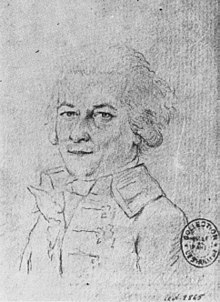Jacques François Blondel
| Jacques-François Blondel | |
|---|---|
 |
|
| Born | 8 January 1705 Rouen, France |
| Died | 9 January 1774 (aged 69) Louvre Palace, Paris, France |
| Occupation | Architect |
| Spouse(s) |
|
| Practice | Neoclassicism |
Jacques-François Blondel (8 January 1705 – 9 January 1774) was a French architect and teacher. After running his own highly successful school of architecture for many years, he was appointed Professor of Architecture at the Académie Royale d'Architecture in 1762, and his Cours d'architecture ("Course of Architecture", 1771–1777) largely superseded a similarly titled book published in 1675 by his famous namesake, François Blondel, who had occupied the same post in the late 17th century.
Born in Rouen, he initially trained under his uncle Jean-François Blondel (1683–1756), architect of Rouen. Jacques-François was in Paris by 1726 and continued his studies with Gilles-Marie Oppenord, from whom he acquired a knowledge of rococo. He also worked with Jean Mariette, contributing to the latter's L'Architecture françoise (1727, 1738), as a writer and as an architectural engraver. Blondel developed into a conservative and thorough architect, whose rationally ordered mind consolidated French classical tradition and practice.
His first independent publication was the hugely influential encyclopedic work, De la Distribution des Maisons de Plaisance, et de la Décoration des Edifices en General, issued at Paris, 1737–38. It contained 155 carefully engraved plates. His Distribution des Maisons de Plaisance and other engraved work attracted a commission to produce thirteen of the engravings for the festival book commemorating the fêtes that celebrated the wedding of Madame Elizabeth of France with Dom Philippe of Spain, published in 1740.
That same year he opened his own private school in Paris, the École des Arts, sanctioned by the Académie in 1743. In the ensuing years a long sequence of architects profited from his discourse: Boullée, Brongniart, Chalgrin, La Guêpière, Desprez, de Wailly, Gondoin, Ledoux, Guimard and Rondelet, and to foreigners who would bring Neoclassicism home with them: the Anglo-Swedish Sir William Chambers, and the Dane Caspar Frederik Harsdorff. "Blondel was the most significant French architectural educator of the eighteenth century.....his objective was to establish design principles for domestic architecture that correspond to the classical principles already in practice for civil structures".
...
Wikipedia
